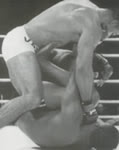martial arts of jiu jitsu
I think it may concerned as Mixed Martial Arts
this syllabus my written as :
ju jitsu, jujutsu, jiu jitsu, jiujitsu, ju jutsu

Derived from the basic principles of boxing with the development of ancient Chinese and the addition of a Chinese theories that rely on knowledge of the sensitive areas of the body and to exploit weaknesses in the movements of attack or arrest on the outskirts of the body in order to break the joints and subtle movements, and paralyzing the adversary.
This sport relies on many types of hazardous Grabs and strikes that
 caused very serious injuries and Security Forces personnel and special forces teams in the Chinese military are learning the sport for the performance of combat tasks required of them, and then leaked the secrets of this game is dangerous to Japan, where the movements have evolved to become later known Japanese self-defense despite the fact that the game is a Chinese origin.
caused very serious injuries and Security Forces personnel and special forces teams in the Chinese military are learning the sport for the performance of combat tasks required of them, and then leaked the secrets of this game is dangerous to Japan, where the movements have evolved to become later known Japanese self-defense despite the fact that the game is a Chinese origin.Jujitsu techniques and Brazilian Jiu-Jitsu (BJJ) moves. Pictures of fighting positions:


Bruce Lee's Fighting Method: The Complete Edition [Hardcover]
Bruce Lee was an iconic figure in martial arts who pioneered the concept of jeet kune do from his physical training, personal research, and formal education in philosophy at the University of Washington, Seattle. He acted in several motion pictures, including The Big Boss, Enter the Dragon, Fists of Fury, and Way of the Dragon. He is the author of Tao of Jeet Kune Do. M.Uyehara is an aikido practitioner and the founder of Black Belt magazine. He served as the owner for more than 30 years and studied jeet kune do under Bruce Lee. He lives near Honolulu, Hawaii.
This Book Vividly illustrating the techniques of a legendary innovator, this definitive examination explains how to survive attacks on the street, increase training awareness, and develop body movements.
Originally compiled as a four-volume series, this revised edition breathes new life into a classic work with digitally-enhanced photography of jeet kune do founder Bruce Lee in his prime, a new chapter by former Lee student Ted Wong, and an introduction by Shannon Lee. This renowned compendium once again reclaims its place as an integral part of the Lee canon and a necessary addition for collectors and martial arts enthusiasts alike.
I remember buying these four volume paperback sets in the late 70's. Back then Bruce Lee was my favorite martial artists (with Bill Wallace and Benny Urquidez immediately following). I wanted to fight like Bruce, kia like Bruce, and be a hero like Bruce.

No comments:
Post a Comment